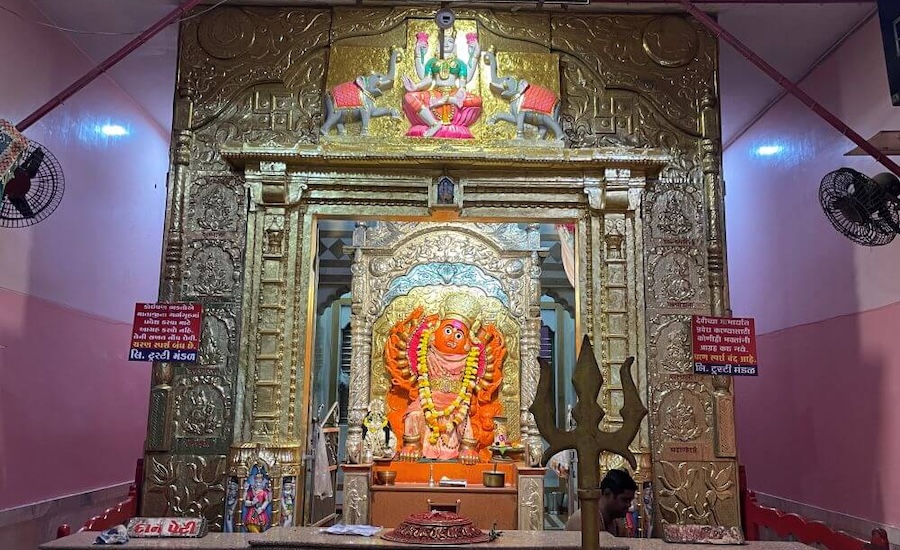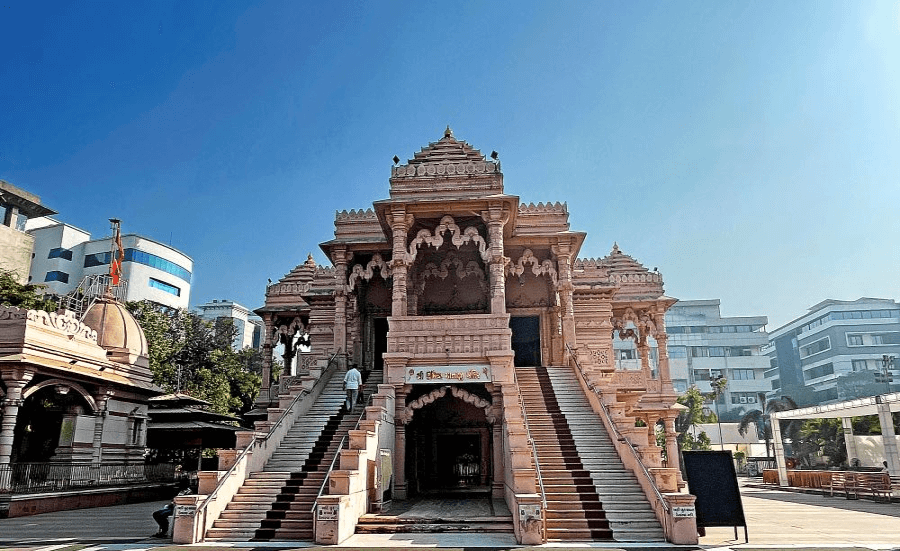
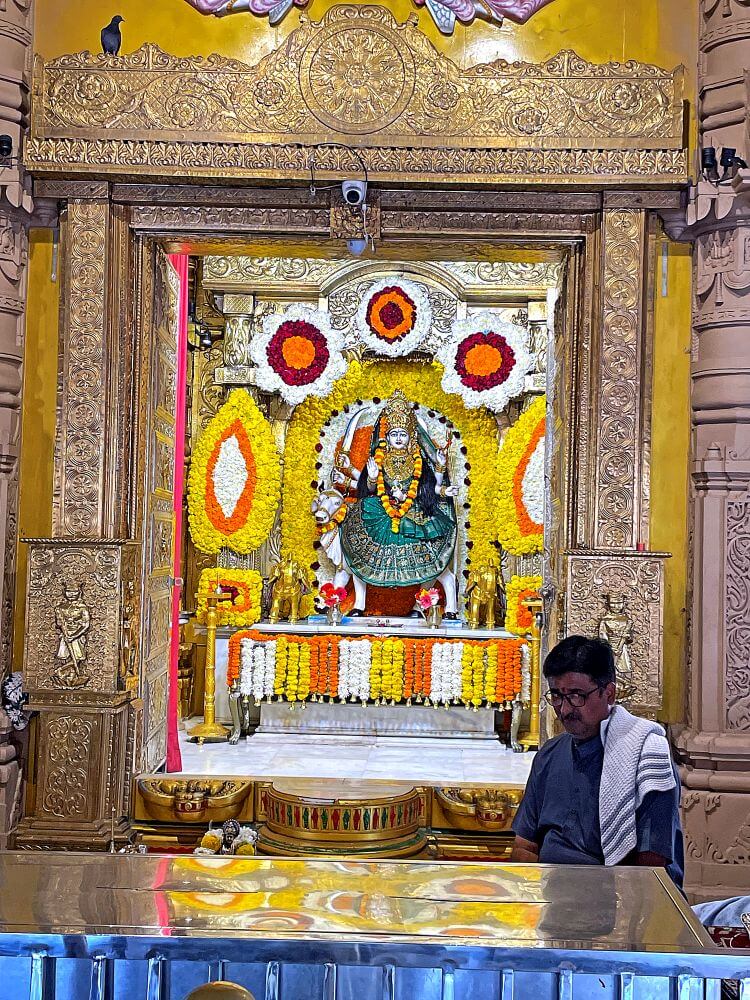 The grand Umiya Mata Temple, located on Varachha Road in Surat, is an architectural marvel and a revered shrine for the Kadva Patidar community, who consider Umiya Mata their kuldevi (family deity). This temple attracts lakhs of devotees and tourists alike. During the Sharadiy Navratri festival, the temple becomes a hub of activity, with thousands of devotees gathering each day. Highlights include the Garba dance performed in the temple’s vast courtyard and the Maha Aarti on the eighth day, Maha Ashtami.
The grand Umiya Mata Temple, located on Varachha Road in Surat, is an architectural marvel and a revered shrine for the Kadva Patidar community, who consider Umiya Mata their kuldevi (family deity). This temple attracts lakhs of devotees and tourists alike. During the Sharadiy Navratri festival, the temple becomes a hub of activity, with thousands of devotees gathering each day. Highlights include the Garba dance performed in the temple’s vast courtyard and the Maha Aarti on the eighth day, Maha Ashtami.
Umiya Mata is considered a form of Parvati, also known as Uma. According to legend, before entering the sacrificial fire, Sati wished that Lord Shiva would again be her husband in her next life. Reborn as Uma, the daughter of King Himavat, she performed rigorous penance and ultimately married Shiva. Post-marriage, Uma was venerated as Umiya Mata and regarded as an incarnation of Annapurna (the goddess of nourishment). It is believed that Seeta, too, worshipped Umiya Mata daily. In King Janaka’s palace garden, there was a temple dedicated to Umiya Mata. During the swayamvara ceremony, Seeta visited this garden to offer prayers at the temple. It was here that she caught her first glimpse of Lord Rama. Deeply moved, she prayed to Umiya Mata, expressing her wish for Rama to become her husband. 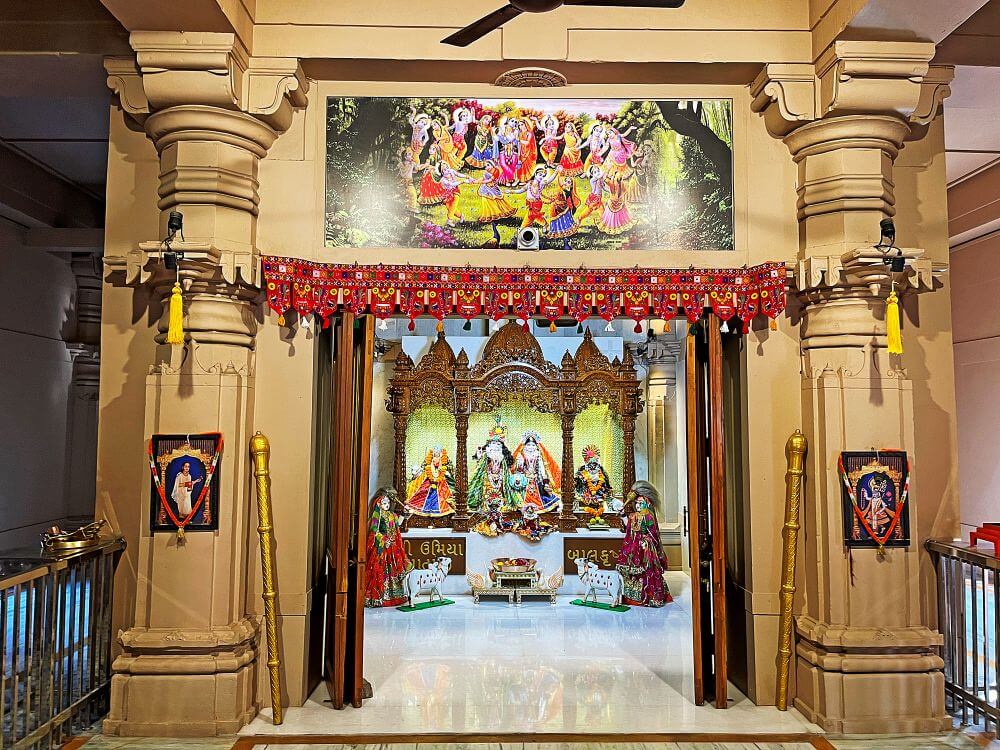 The goddess blessed her and as a result, Seeta’s heartfelt desire was fulfilled, leading to her union with Lord Rama. Before departing the earth, Seeta entrusted her sons, Luv and Kush, to Umiya Mata’s care. Subsequently, they and their descendants worshipped the goddess as their kuldevi.
The goddess blessed her and as a result, Seeta’s heartfelt desire was fulfilled, leading to her union with Lord Rama. Before departing the earth, Seeta entrusted her sons, Luv and Kush, to Umiya Mata’s care. Subsequently, they and their descendants worshipped the goddess as their kuldevi.
Umiya Mata is the principal deity of the globally prominent Kadva Patidar community. Historical records trace the community’s roots to the Sindhu civilization, evolving from Kurmi Kshatriyas, primarily farmers. Around 1000 CE, foreign invasions led some Kurmis to migrate from Punjab to Unjha in North Gujarat. Those from Punjab’s Karad region became known as Kadva Kurmis and over time, the name evolved into Kadva Patidars. Their arrival in Unjha established Umiya Mata as their family deity. Today, a grand temple dedicated to Umiya Mata is being built in Ahmedabad, estimated to cost ₹1,500 crore.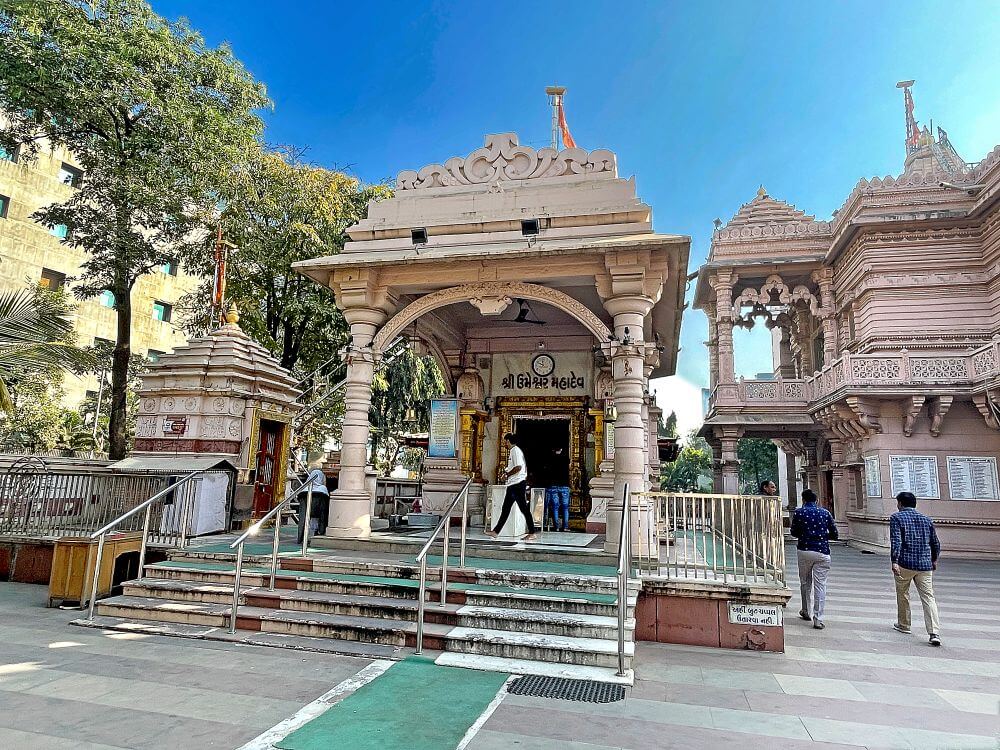 The Surat temple was established by the Umiya Parivar Trust in 1983, with sandstone and artisans brought from Rajasthan.
The Surat temple was established by the Umiya Parivar Trust in 1983, with sandstone and artisans brought from Rajasthan.
Spanning 132 feet in length, 85 feet in width and 71 feet in height, with a 16.5-foot-high flagpole and 62 intricately carved pillars, this temple reflects traditional Gujarati architectural styles. The temple complex features a high boundary wall, with a grand, ornamental gateway reminiscent of royal palaces. The columns are adorned with elaborate carvings, including relief sculptures of female attendants (dwarsevikas). Above the gateway, statues of Riddhi-Siddhi with Lord Ganesha adorn the roof. On either side of the main entrance, there are smaller entryways. Above these entryways, the ceiling features a beautiful idol of the goddess seated in Padmasana (lotus position) and displaying the Abhaya Mudra (gesture of protection).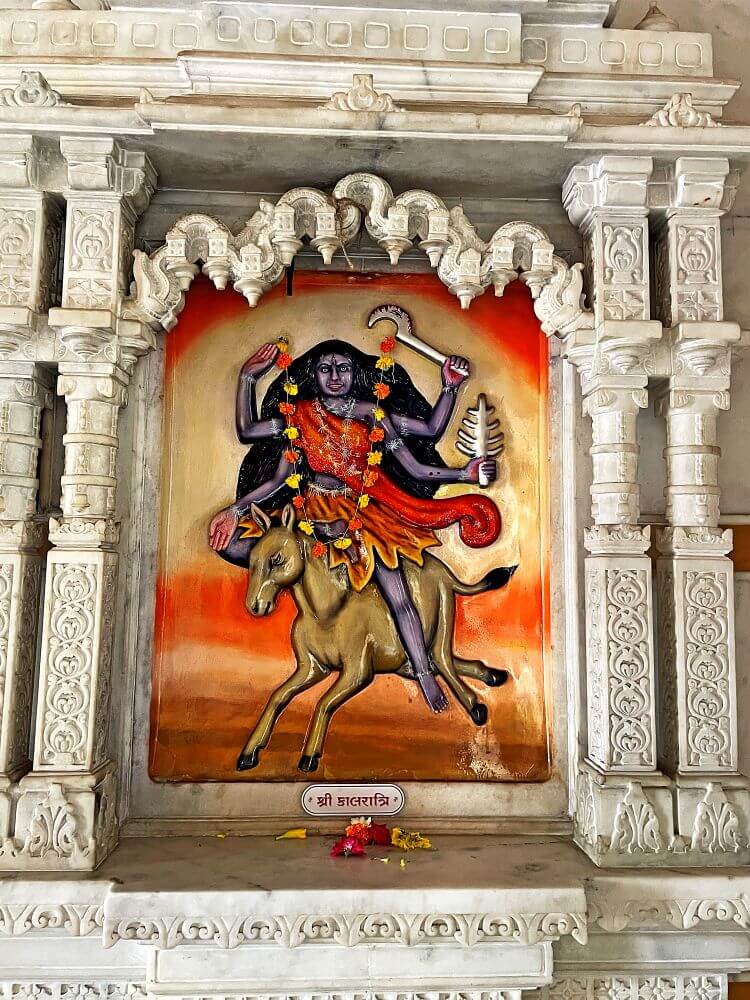 Adjacent to this idol, exquisite sculptures of swans and peacocks enhance the artistic elegance of the design.
Adjacent to this idol, exquisite sculptures of swans and peacocks enhance the artistic elegance of the design.
The temple courtyard is entirely paved with marble tiles, adding to its grandeur. Right in front stands a two-storeyed temple of Umiya Mata. On the ground floor, at the centre, is the Radha-Krishna temple. This temple features a Mukhamandapa (entrance hall), with an open space in front leading to a grand Sabhamandapa (assembly hall). The Sabhamandapa has three entrances, each adorned with intricately carved doorframes showcasing fine craftsmanship. The door pillars of the temple feature beautifully sculpted figures of Dwarsevikas (gate attendants). On either side of the sanctum’s entrance, there are large golden columns (danda). Above the doorframe, a magnificent painting adorns the wall, depicting Krishna in various Raasa Leela postures accompanied by the Gopis.
Inside the sanctum, on an elevated and intricately carved pedestal, stands the central idol of Radha-Krishna, flanked on one side by Umiya Mata and on the other by Balakrishna, completing the divine ensemble.
On either side of the entrance hall (mukhamandapa) of Radha-Krishna temple, tall staircases lead upward, comprising 32 steps, providing access to the main mukhamandapa of the Umiya Mata Temple. 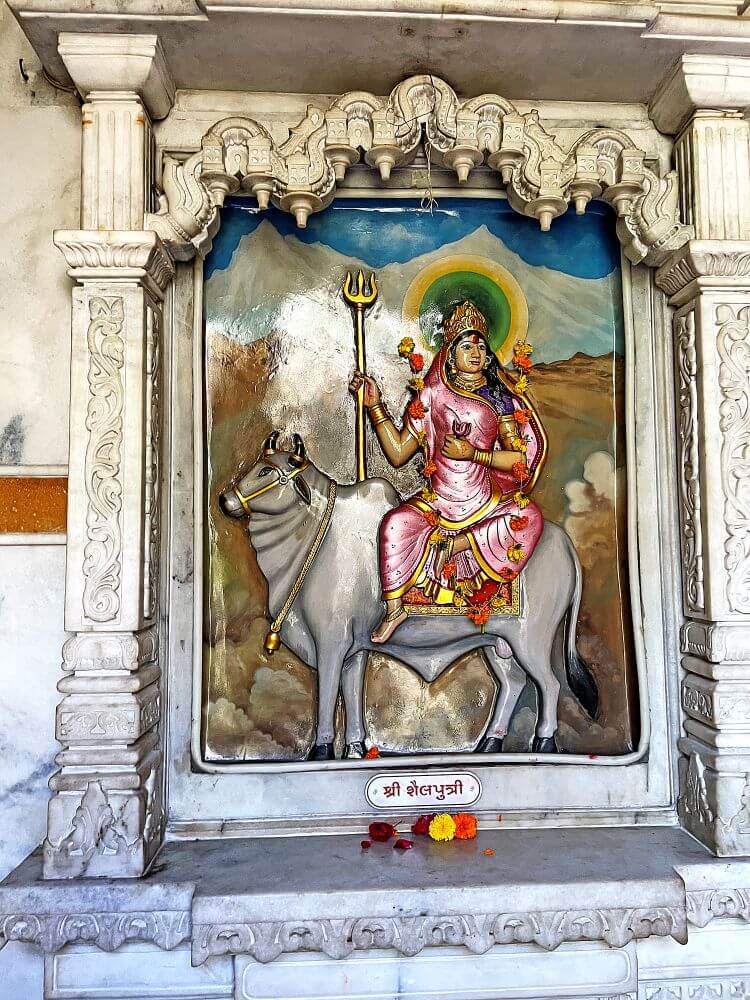 In this hall, on an elevated platform, there is a majestic statue of a lion, symbolizing power and divinity.
In this hall, on an elevated platform, there is a majestic statue of a lion, symbolizing power and divinity.
The temple’s assembly hall (sabhamandapa) features three exquisitely carved entryways, each adorned with intricate artwork. Below these entrances, Dwarapalas (gatekeepers) are positioned as guardians, while the lintel (lalatabimba) above the doorframes displays a beautifully sculpted image of Lord Ganesha.
The door panels leading to the assembly hall are covered in silver plating, with detailed carvings depicting various forms of the goddess. The columns of the assembly hall are grand and intricately sculpted, adorned at their tops with graceful figures of Sur Sundaris (celestial maidens). The ceiling is also richly decorated with intricate designs.
The assembly hall has additional entrances on both sides, leading to adjacent mukhamandapas, each topped with pyramid-shaped spires, blending architectural beauty with spiritual significance.
The sanctum sanctorum (garbhagriha) of the temple is connected to the assembly hall (sabhamandapa) by a circumambulatory path (pradakshina marg), allowing devotees to perform sacred rounds. The outer walls of the 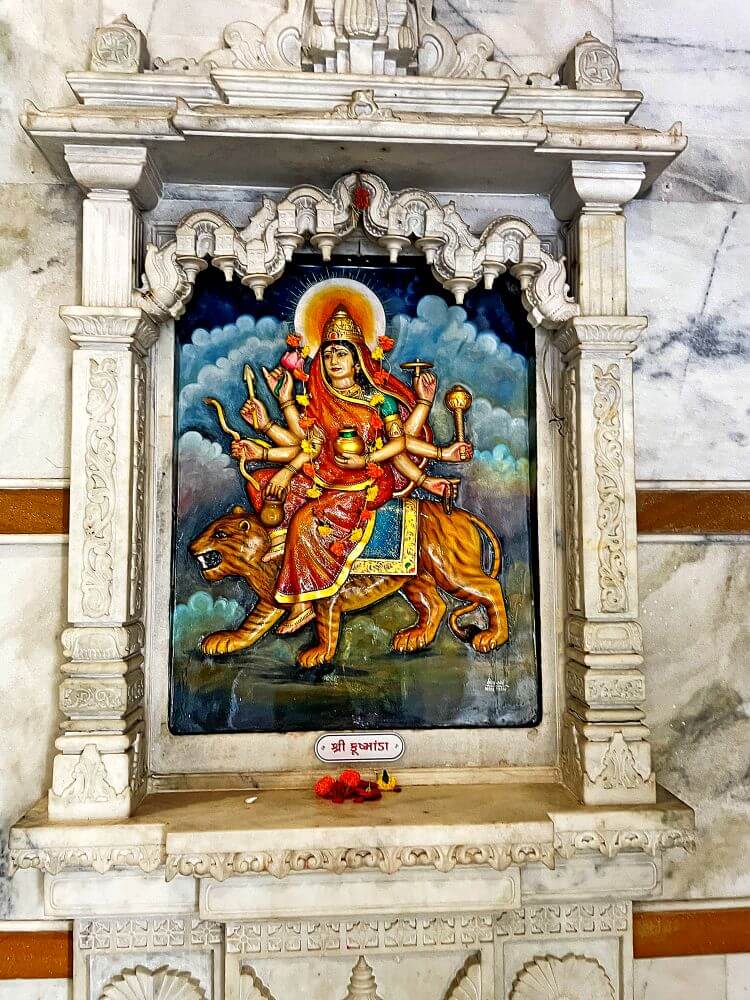 sanctum and the sabhamandapa feature sculptures of various forms of the goddess, including Kalaratri, Katyayani, Skandamata, Brahmacharini, Kushmanda, Chandraghanta and Shailaputri. Additionally, a statue of Lord Ganesha is enshrined here, symbolizing auspiciousness and the removal of obstacles.
sanctum and the sabhamandapa feature sculptures of various forms of the goddess, including Kalaratri, Katyayani, Skandamata, Brahmacharini, Kushmanda, Chandraghanta and Shailaputri. Additionally, a statue of Lord Ganesha is enshrined here, symbolizing auspiciousness and the removal of obstacles.
The doorframe of the sanctum’s entrance bears a Ganesh idol at the lintel (lalatabimba). Inside the sanctum, there is a stunning marble idol of the goddess seated on Nandi (Lord Shiva’s mount), housed in an intricately decorated and gold-plated canopy (makhara). The idol of Umiya Mata is adorned with ornate attire and ornaments and the deity holds a sword, shield, discus (chakra), trident (trishula) and other divine weapons in her hands. One hand carries a lotus flower, while another offers blessings in a gesture of protection (abhaya mudra). A golden crown adorns her head and the halo (prabhaavali) behind the idol features intricate craftsmanship. On either side of the goddess, there are gilded elephant statues, further enhancing the sanctity and splendor of the sanctum.
Within the temple complex, to the left of the main shrine, is the Umeshwar Mahadev Temple, dedicated to Lord Shiva. Nearby, there are also shrines for Lord Hanuman and Sheetaladevi, reflecting the temple’s spiritual diversity. The premises also house a yajna shala (sacrificial fire hall), a dining hall and the trust’s administrative office, ensuring that all facilities for worshippers and visitors are provided.
At this temple daily rituals begin at 5:00 AM, with mangala aarti at 6:30 AM, followed by offerings such as Balbhog at 7:15 AM and Rajbhog at 11:25 AM. Devotees can participate in the sandhya aarti (evening prayer) and the shayan aarti (night prayer). Each day, the deity is adorned with sarees in specific colours – Monday: White, Tuesday: Red, Wednesday: Green, Thursday: Yellow, Friday: White, Saturday: Sky Blue and Sunday: Red.
The temple hosts grand celebrations for Navratri, Vasant Panchami, Annakut Utsav and the goddess’s pragat din (manifestation day). During Navratri, the temple transforms into a cultural hub, with women performing Garba dance, holding traditional lamps. On Maha Ashtami, over 30,000 devotees gather for a grand Maha Aarti, lit solely by the glow of devotional lamps.
